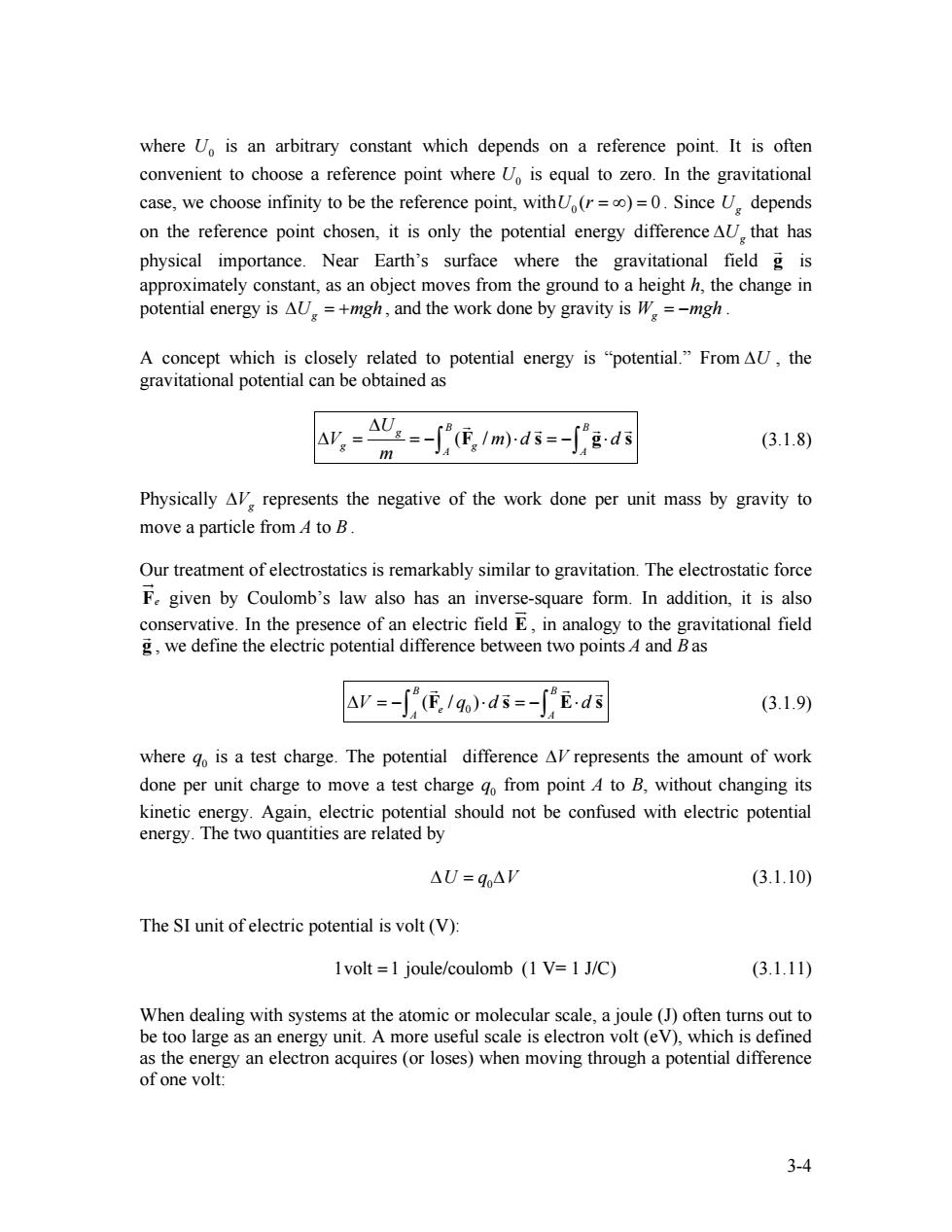正在加载图片...

where Uo is an arbitrary constant which depends on a reference point.It is often convenient to choose a reference point where U is equal to zero.In the gravitational case,we choose infinity to be the reference point,withU(r=)=0.Since U depends on the reference point chosen,it is only the potential energy differenceAU.that has physical importance.Near Earth's surface where the gravitational field g is approximately constant,as an object moves from the ground to a height h,the change in potential energy is AU=+mgh,and the work done by gravity is W.=-mgh. A concept which is closely related to potential energy is "potential."From AU,the gravitational potential can be obtained as .-g=可e/mds=-d (3.1.8) Physically Al represents the negative of the work done per unit mass by gravity to move a particle from A to B. Our treatment of electrostatics is remarkably similar to gravitation.The electrostatic force F.given by Coulomb's law also has an inverse-square form.In addition,it is also conservative.In the presence of an electric field E,in analogy to the gravitational field g,we define the electric potential difference between two points 4 and Bas Ay=-∫./gds=-∫Eds (3.1.9) where go is a test charge.The potential difference Al represents the amount of work done per unit charge to move a test charge do from point 4 to B,without changing its kinetic energy.Again,electric potential should not be confused with electric potential energy.The two quantities are related by △U=qo△V (3.1.10) The SI unit of electric potential is volt (V): 1volt =1 joule/coulomb (1 V=1 J/C) (3.1.11) When dealing with systems at the atomic or molecular scale,a joule (J)often turns out to be too large as an energy unit.A more useful scale is electron volt (eV),which is defined as the energy an electron acquires(or loses)when moving through a potential difference of one volt: 3-4where is an arbitrary constant which depends on a reference point. It is often convenient to choose a reference point where is equal to zero. In the gravitational case, we choose infinity to be the reference point, with U0 U0 0 U r( = ∞ =) 0 . Since Ug depends on the reference point chosen, it is only the potential energy difference ∆Ug that has physical importance. Near Earth’s surface where the gravitational field g G is approximately constant, as an object moves from the ground to a height h, the change in potential energy is ∆Ug = +mgh , and the work done by gravity is W m g = − gh . A concept which is closely related to potential energy is “potential.” From , the gravitational potential can be obtained as ∆U ( / ) B g g g A U V m d m ∆ ∆ = = − ⋅ = − ⋅ ∫ F s B A d ∫ g s G G G G (3.1.8) Physically ∆Vg represents the negative of the work done per unit mass by gravity to move a particle from A B to . Our treatment of electrostatics is remarkably similar to gravitation. The electrostatic force given by Coulomb’s law also has an inverse-square form. In addition, it is also conservative. In the presence of an electric field E Fe JG JG , in analogy to the gravitational field g G , we define the electric potential difference between two points A B and as 0 ( / ) B e A ∆ = V q − ⋅ d = − ⋅ ∫ ∫ F s E B A d s G G G G (3.1.9) where is a test charge. The potential difference 0 q ∆V represents the amount of work done per unit charge to move a test charge from point A to B, without changing its kinetic energy. Again, electric potential should not be confused with electric potential energy. The two quantities are related by 0 q ∆U q = ∆0 V (3.1.10) The SI unit of electric potential is volt (V): 1volt =1 joule/coulomb (1 V= 1 J/C) (3.1.11) When dealing with systems at the atomic or molecular scale, a joule (J) often turns out to be too large as an energy unit. A more useful scale is electron volt (eV), which is defined as the energy an electron acquires (or loses) when moving through a potential difference of one volt: 3-4